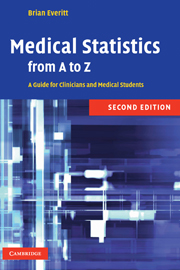B
Published online by Cambridge University Press: 23 December 2009
Summary
Back-calculation: A method of estimating past infection rate of an epidemic infectious disease by working backwards from observed disease incidence rate using knowledge of the incubation period between infection and disease. Used mainly for reconstructing plausible HIV incidence curves from AIDS incidence data. Limitations of the approach are that it provides little information about recent infection rates and that projections can be sensitive to recent incidence. [Statistical Science, 1993, 8, 82–119.]
Background level: The usually low concentration of some substance or agent that is characteristic of a particular time or place rather than a specific hazard. An example is the background level of naturally occurring forms of ionizing radiation to which nearly everybody is exposed.
Back-projection: Synonym for back-calculation. Backward elimination: See selection methods in regression.
Backward-looking study: An alternative (and unattractive) term for retrospective study.
Balaam's design: A design for testing differences between two treatments, A and B, in which patients are allocated randomly to one of four sequences, AA, AB, BA or BB. See also crossover design. [Statistics in Medicine, 1988, 7, 471–82.]
Balanced design: A term usually applied to any experimental design in which the same number of observations is taken for each combination of the experimental factors. See also non-orthogonal design. Balanced incomplete block design: An experimental design in which not all treatments are used in all blocks. Such designs have the following properties:
Each block contains the same number of units.
Each treatment occurs the same number of times in all blocks.
Each pair of treatment combinations occurs together in a block the same number of times as any other pair of treatments.
- Type
- Chapter
- Information
- Medical Statistics from A to ZA Guide for Clinicians and Medical Students, pp. 18 - 34Publisher: Cambridge University PressPrint publication year: 2006



